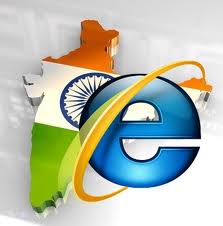 Already one of the largest economies in the world and set to become the most populous country in the world by 2020, India is enjoying its golden years and developing at an exponential rate. With over 100 million internet users, India has one of the biggest online communities in the world, so it might come as a surprise to know only 12 million are using a broadband connection, with 85{af589cdba9d77786c8c861317dbad60bba1e2ebbf56e2ffab874a1b59fde9ce3} of these connecting via DSL on copper cable and struggling with speeds of around 256kbps. With end users putting pressure on providers for more bandwidth and faster speeds, the race is on to see whether fibre optic or mobile broadband becomes the technology of choice.
Already one of the largest economies in the world and set to become the most populous country in the world by 2020, India is enjoying its golden years and developing at an exponential rate. With over 100 million internet users, India has one of the biggest online communities in the world, so it might come as a surprise to know only 12 million are using a broadband connection, with 85{af589cdba9d77786c8c861317dbad60bba1e2ebbf56e2ffab874a1b59fde9ce3} of these connecting via DSL on copper cable and struggling with speeds of around 256kbps. With end users putting pressure on providers for more bandwidth and faster speeds, the race is on to see whether fibre optic or mobile broadband becomes the technology of choice.
The United Nations are pushing for internet access to become a basic human right, yet in many rural areas of India there is no connectivity at all. The Indian government believes that internet access for all is about far more than just getting online to shop, browse or communicate. Indeed Sachin Pilot, the Minister of State for Communications, believes improvements in IT will help to stabilise Indian economic growth, tackle corruption and tackle poverty and development issues. Currently around 40{af589cdba9d77786c8c861317dbad60bba1e2ebbf56e2ffab874a1b59fde9ce3} of Indians don’t have bank accounts and only 5{af589cdba9d77786c8c861317dbad60bba1e2ebbf56e2ffab874a1b59fde9ce3} of villages have physical banks, so the introduction of mobile broadband devices or access via a dongle could potentially revolutionise the way these villages are operating, trading and investing.
Pilot is leading on a multi-billion pound programme to roll out broadband to every corner of the nation. He believes this is money well spent, as he estimates that for every 10{af589cdba9d77786c8c861317dbad60bba1e2ebbf56e2ffab874a1b59fde9ce3} increase in broadband penetration, the Indian economy grows by around 1.5{af589cdba9d77786c8c861317dbad60bba1e2ebbf56e2ffab874a1b59fde9ce3}. Internet services in India have traditionally been offered by state-owned telecom companies operating over a switched network using traditional copper cabling, but the rapid growth of the economy coupled with end user demand has forced companies to roll out fibre-optic replacements which will provide high speed bandwidth using fibre to the home (FTTH).
However, this replacement programme is only being carried out mainly to existing connections, so rural India would still lose out. However, the National Broadband Plan which the government has kicked off aims to bridge that gap by connecting 160 million Indian households with high speed internet by the year 2014.The possibility of high-speed wireless broadband for every Indian is not only exciting, but is also opening doors to other broadband providers who may lease parts of the network and create a new era of increased competition and ultimately lower prices for the service.
It may seem that wireless broadband has the Indian market all sewn up, but there is another contender in the race to secure the nation’s future communications. Currently, mobile broadband providers are racing to roll out high-speed 3G services across the nation, offering users potentially higher speeds and greater flexibility than the FTTH programme will be able to compete with. Last summer, companies bid to buy bandwidth from the state-owned telecoms companies, paying in total around $23 billion (£15bn) for the privilege. To date, the promised 7-8 mbps speeds and 100{af589cdba9d77786c8c861317dbad60bba1e2ebbf56e2ffab874a1b59fde9ce3} 3G coverage for phones, tablets and computers through a dongle have not materialised for everyone, but are certainly well on their way and there are even murmurs of a 4G roll out in the not-too-distant future.
Another factor to consider is the tablet revolution. A day after the Apple iPhone 4S was launched in the UK, a tablet was released in India called the Aakash which has taken the crown as the world’s cheapest tablet computer. Sold to students for the equivalent of £22 and on the open market for £38, this little piece of technology could be the deciding influence in the broadband wars. Mobile broadband and smart phone adoption in India has been rapid and experts are predicting that the number of tablet users will increase at an annual growth rate of 107{af589cdba9d77786c8c861317dbad60bba1e2ebbf56e2ffab874a1b59fde9ce3} to reach a total of 23.38 million by 2017.
With both technologies promising massive improvements over the next 12 – 24 months, price is going to have a massive impact on the success of each. Currently, mobile broadband data allowances are low and additional data expensive, but once the infrastructure is in place, doors will open to competition and prices will be driven down. It is hard to predict which technology will come out as top dog in the Indian race, but one thing is for sure: it will not be so much a sprint, but more of a marathon which will secure the winner in this ever-expanding marketplace.
